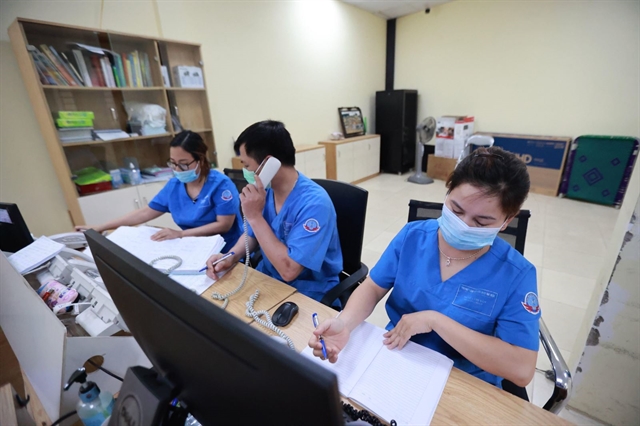
HÀ NỘI – There is rarely a quiet moment at Hà Nội Medical Emergency Centre 115 when the telephones don’t ring off the hook.
All hours day and night, the hotline phones never stop, with the centre receiving as many as 2,000 calls each day – more than one call each minute.
Since last August, the centre has mainly focused on transporting COVID-19 patients.
From November, as the number of COVID-19 infections increased rapidly in the city, the centre ferried patients with moderate and severe illnesses to medical facilities.
Team leader Ngô Thị Hà said the day begins with each member of staff getting themselves tested for COVID.
Only then with a negative result do they get behind the wheel.
One call they received recently was to inform them the health of a patient in Hai Bà Trưng District was deteriorating rapidly.
Hà’s first task was to make contact with the local medical facility in the area to make sure the patient’s medical records were available, and the family would be ready when the emergency team arrived.
By the time the ambulance got there, the patient’s SpO2 (blood oxygen level) had dropped to 94 per cent, worryingly close to dangerous levels.
The patient was awake but unable to walk on her own because of stage 3 bone cancer and high blood pressure.
After the initial emergency treatment, the whole team and local health workers carried the patient to the ambulance, transferring her to the Việt Đức Friendship Hospital.
Hà said: “Because the patient’s blood oxygen index was low, there were signs of respiratory failure, so as soon as the patient got on the ambulance, we had to quickly give her oxygen.”
Hà said that 115 emergency doctors also had to check if the hospital was ready to receive the patient.
“Such emergency trips continue throughout my day,” she added.
Đỗ Thị Thu Thủy, a nurse at the centre said that since the pandemic began, their work had become much more stressful.
On peak days, each crew has to run up to 22 trips, including transporting severe COVID-19 patients and patients with underlying medical problems.
“In many cases, after transferring a patient to a hospital, we are on the way back to the centre but soon change direction to reach another patient,” Thủy said.
“Working at these times is very stressful and tiring. We hardly have time to rest.”
In the control centre, coordinators receive information, dispatch vehicles and connect with patients.
Nguyễn Thanh Huyền, a coordinator at the centre, said: “We receive calls from F0 cases who take treatment at home through to severe cases of F0 who require hospitalisation.
“Currently, we focus on giving priority to immediately transport the F0s with moderate and severe illness.”
“When we receive calls from the patients, we contact the medical station at their wards or communes to check patient information and contact with hospitals that we plan to take them to.
“The number of calls to Centre 115 has increased a lot, the pressure is much higher. There are days when the centre receives up to 2,000 calls.”
Doctor Trần Anh Thắng, deputy director of the centre, said that thanks to high vaccine coverage, the rate of cases that had to go to medical facilities was low. However, as new infections had risen, the number of critically ill patients was higher than previously.
Currently, the centre transports about 60-70 patients a day.
Thắng said that seeing the serious COVID-19 outbreaks in HCM City a few months ago, the Hà Nội Emergency Centre 115 urgently submitted a project to the Hanoi Department of Health on improving coordination capacity, and operating ambulances throughout the city.
The centre had also been proactive in preparing human resources and equipment, increasing the number of emergency hotlines from six to 24.
With current COVID-19 development in Hà Nội, the centre had used 12 lines.
“Since the start of the pandemic, we have continuously trained in infection prevention and control, prepared sufficient medical equipment, protective clothing for medical staff,” he said.
The centre also changed working hours to reduce contact among employees, he said, adding that a medical worker would work continuously for a 24 hour period and then take 48 hours off. So, they would have time to rest after stressful working hours and avoid contact with other staff. —VnExpress News
- Reduce Hair Loss with PURA D’OR Gold Label Shampoo
- Castor Oil Has Made a “Huge” Difference With Hair and Brow Growth
- Excessive hair loss in men: Signs of illness that cannot be subjective
- Dịch Vụ SEO Website ở Los Angeles, CA: đưa trang web doanh nghiệp bạn lên top Google
- Nails Salon Sierra Madre
 VnExpress News The News Gateway of Vietnam
VnExpress News The News Gateway of Vietnam





